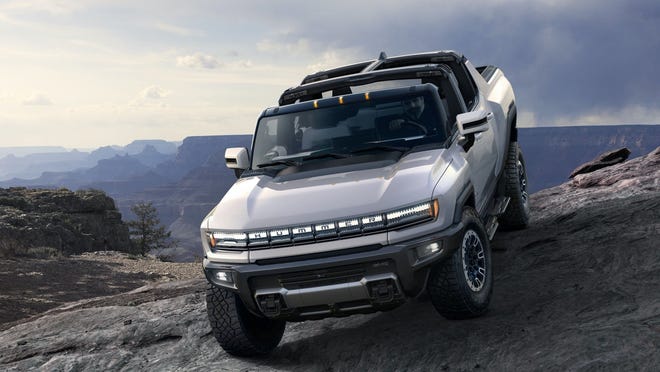
While 2021 could be the year of the electric pickup, a back-from-the-dead, gas-powered SUV is occupying center stage in the automotive world.
While Tesla, General Motors and others are poised to make a splash with the release of battery-driven trucks, Ford has seized the spotlight with its much-awaited revival of the Ford Bronco.
The Bronco leads the list of 2021’s most anticipated new vehicles, according to analysts and a USA TODAY analysis of industry buzz.
“I would say the Bronco is definitely in the lead,” said Jessica Caldwell, executive director of insights at the car research site Edmunds. “They’ve put so much product muscle behind it.”
Bronco delayed:COVID-19 leads to supplier bottlenecks
Tesla Cybertruck design stuns:'Eccentric,' 'eye-popping' or 'weird' 'piece of junk'?
Much like the Bronco, there are several other cases of automakers reviving the nameplates of vehicles from days gone by, such as the Jeep Wagoneer and Land Rover Defender.
“Just as we see cars dying, we see lots of new and cool SUVs coming,” said Karl Brauer, executive analyst at car shopping site iSeeCars. But “nobody’s introducing an all-new sedan model in 2021.”

Here are some of the most anticipated new vehicles of 2021:
Ford Bronco
The infamous O.J. Simpson chase involving a white Bronco in 1994 is beginning to feel like a distant memory. Look no further than the fervor surrounding this vehicle, which is poised to make its debut in the summer after supplier bottlenecks caused a delay.
“It’s the hot commodity for 2021 undeniably,” Brauer said.
Jeep Wagoneer and Grand Wagoneer
These SUVs reflect a revival of a nameplate that had been gathering dust for Fiat Chrysler, which makes the Jeep brand.
The Wagoneer is geared toward mainstream buyers, while the Grand Wagoneer is aimed more at luxury buyers.
GMC Hummer EV
GM’s decision to revive the Hummer as an electric pickup caused the essence of cognitive dissonance, given that the original Hummer brand was a gas-guzzling SUV.
No matter. The initial version of the battery-powered Hummer, which is being sold at more than $100,000, is unmistakably different than its cheaper fossil-fuel predecessor.
But will people actually buy electric pickups or do they just like talking about them?
“I’m still somewhat doubtful because it is more expensive, you don’t have necessarily the whole country that needs this,” Caldwell said. “Sure, in cities this works well. But in suburbs or more rural areas, I don’t think these are necessarily needed, especially if you’re paying more.”
Tesla Cybertruck
This may be the most dubious entry on this list, if only because analysts question whether it will actually be released in 2021. But Tesla technically has said its new electric pickup is poised to roll out in late 2021.
We’ll see. One thing’s for certain: The Cybertruck’s unique styling, including its stainless steel body and shatter-proof windows, are eye-catching, to say the least.
Rivian R1T and R1S
Automotive start-up Rivian’s R1T pickup and R1S SUV are grouped together because they’re based on the same vehicle architecture and are generally viewed as having their fates intertwined.
The electric vehicles have won praise from critics who like their look and appreciate Rivian’s deliberate approach to engineering and manufacturing. But it remains to be seen whether Rivian can manufacture the vehicles effectively and generate a sustainable base of buyers. The company has already faced delays.
“It is probably the most impressive EV company in my mind that’s in that pre-launch mode,” Brauer said. “So I have fairly big expectations and fairly confident hopes that it’s going to be a successful EV.”
Ford Mustang Mach-E
This is the long-awaited electric crossover version of Ford’s iconic pony car.
It has certainly received a lot of attention from the press. But can the Mach-E attract buyers? A recent price cut of up to $3,000 didn’t inspire confidence. But maybe that’s more of an indication of Ford’s efficiency than customer disinterest.
“If you’re looking at buzz because people are talking about it, the Mach-E is right up there,” Brauer said. “But if you’re thinking it’s going to change the face of the market with its sales or make Ford a bunch of money, I think most of us know that’s not going to happen.”
Land Rover Defender
Much like other automotive brands are digging into their history to revive much-beloved-but-long-discontinued nameplates, Land Rover is bringing back the Defender.
The boxy four-wheel drive Defender – originally known as the Series I – was sold by Land Rover for about seven decades before it was briefly discontinued globally in 2016. The vehicle hasn't been sold in the USA since 1997.
Lucid Air
Silicon Valley-based start-up Lucid Motors is led by a former chief engineer of Tesla’s Model S luxury sedan, lending instant credibility to its electric vehicle efforts.
The company says it has developed a proprietary electric motor, electricity inverter and stackable battery pack based on its expertise in developing batteries for Formula E race cars.
It will debut the system in the Lucid Air, which it says will have a battery range of more than 500 miles in certain versions. Its slick design is drawing a lot of attention. But can Lucid execute on the basics of automotive manufacturing?
“We’re hopefully past the era of vaporware EVs, and I think Rivian and Lucid represent what seem to be real” vehicles, Brauer said.
Chevrolet Bolt EUV
If at first you don’t succeed with a car, try an SUV.
It might not be fair to say that the original Chevrolet Bolt, a hatchback of sorts, hasn’t succeeded. The electric car has an excellent range and a competitive price, at least compared with Tesla vehicles. But it hasn’t been the hit that some hoped.
So GM is now extending the Bolt nameplate to a larger body style: an SUV, naturally. It's called the Bolt EUV, which means electric utility vehicle. Maybe this is the one.
Jeep Wrangler 4xe
Listen, whenever there’s a new Wrangler, people are going to take notice.
But that’s especially the case with a plug-in hybrid version like the Wrangler 4xe. Boasting one of the most loyal fan bases in the auto business, the Wrangler can do no wrong in some people’s eyes. Whether that continues with the electric pivot is harder to say.
Nissan Ariya
About a decade after introducing the first mass-market electric car of the century in the U.S. – the Leaf – Nissan is poised to roll out its first electric crossover.
While the Leaf hasn’t captured the audience Nissan had hoped for, the company is hoping that the Ariya will get it right. With up to 300 miles of battery range, the vehicle is expected to hit U.S. dealerships in the second half of 2021.
But is it too edgy?
“The design is pretty polarizing,” Caldwell said.
Volkswagen ID.4
While Volkswagen has sold low-volume electric vehicles before, this is the first one intended to grab a sizable share of the brand’s buyers.
And it’s the first of an onslaught of forthcoming electric vehicles from the world’s largest automaker by sales.
Genesis GV70 and GV80
Hyundai’s luxury brand has received notable accolades for its savvy design and strong quality. But so far all of the brand’s vehicles have been passenger cars, and those aren't selling too well.
That could change with the brand’s first two SUVs: the GV70 and GV80.
Follow USA TODAY reporter Nathan Bomey on Twitter @NathanBomey.









